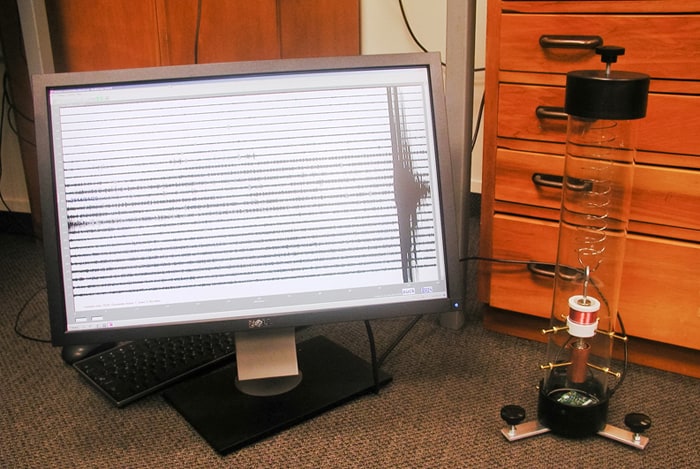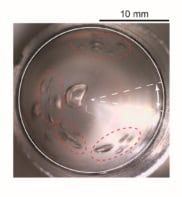
A novel design for an educational seismometer is shaking up physics lessons in New Zealand and the US. Based on a vertical, slinky-like coiled-spring design, the “TC1 seismometer” is both cheap and robust, making it an ideal tool for teaching students of all ages about the physics of the Earth.
“Seismometers for Schools” projects are a great way to teach a wide range of scientific topics. By examining or even assembling a seismometer in the classroom, students benefit from hands-on experience as they learn about the geophysics behind earthquakes and the sensors that detect them. While such educational programmes can be found running in many countries – including the UK, Australia, Europe and the US – they have traditionally been somewhat expensive, with demonstration seismometers ranging in cost from around £450 to £1000.
Cheap, cheerful and sturdy
To address this issue, Ted Channel of Boise State University has come up with an alternative. Wrapped in a transparent case – allowing students to freely examine its inner workings – the TC1 is a vertical seismometer with an elegantly simple design and a cost of only $350 (around £210), making it significantly cheaper than its counterparts.
The TC1 works using a coiled spring, which suspends a small neodymium magnet. This magnet hangs within a coil of copper wire, which is attached to an outside case. When ground movement shakes the seismometer, the hanging magnet acts as a harmonic oscillator, remaining still in relation to the motion of the copper coil, in which a measureable current is induced. To isolate ground movements from the ringing of the oscillator, a second magnet, suspended beneath the first, damps the system by inducing eddy currents in a surrounding cooper tube. The resulting signal is then translated and filtered by a microcontroller, whose USB output can be plugged directly into a computer.

Kasper van Wijk – the physicist who brought the TC1 project from Boise State to the University of Auckland – explains that the design is ultimately a balance between data quality and practicality. “We needed something that was bulletproof,” he says, “that could resist kids kicking it and jumping [around] it.” The vertical design of the TC1 is key in acting to keep the device in equilibrium; traditional, horizontal solutions, while more precise, rely on a precise internal balance that is less resistant to being jostled in a classroom setting.
Global records
Of course, professional seismologists might dismiss the TC1 as being nothing more than a toy; a notion seemingly supported by the device’s harmonic frequency of around 1 Hz, at which many seismic signals are absorbed by the Earth. Despite this, however, the TC1 is still capable of detecting earthquakes of magnitudes greater than six globally, and local events of magnitudes greater than four.
To this date, the project has placed seismometers in around 50 schools in New Zealand, America and Australia. These seismic stations are gathered in an online network, called the Z-NET. Ten more stations in New Zealand are also planned, following a grant from the Society of Exploration Geophysicists. At Boise State – and possibly soon in Auckland – the TC1s have also been used as the foundation of a service learning programme. In this, second-year university students assemble TC1s in their classes, before taking the finished seismometers to local schools to teach the younger students, thereby cementing their own understanding of the physical principles behind the device.
Open-source spirit
The TC1 is suitable for kids of all ages, “from 5 to 80”, jokes Van Wijk, and – being based on principles of open hardware and software – the designs are freely available for any individual or school to construct their own. The researchers even report having received 3D-printing templates, made by an enthusiast, which could be used to produce the TC1’s component parts. Certainly, interest in the novel design is growing, with Van Wijk reporting that the Australian school seismometer programme has recently purchased 10 TC1s for use alongside the research-grade devices that they have traditionally placed in their schools.
Paul Denton, who leads the School Seismology Project at the British Geology Survey (BGS), says that he is “very impressed by the simplicity and cheapness of [the TC1] design”. Following the TC1’s open-source spirit, the BGS is now developing its own version, in collaboration with MindsetsOnline, a UK not-for-profit company that specializes in educational toys and learning aides. The aim is to make a simpler and cheaper model, Denton says, adding that “the key components are still a mini-slinky in a Perspex tube, but we have coupled this with a new 16-bit USB digitizer that can work with either a PC running free data-logging software, or now with code running on Raspberry Pi systems, allowing cheap seismology to provide a real-world link for computer science projects”.
The design of the TC1 seismometer is published in The Physics Teacher.



